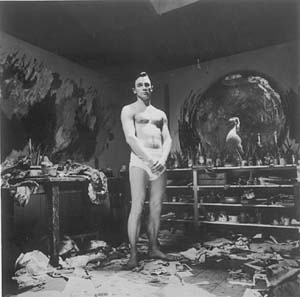Brush With Fame
'Love Is the Devil' paints lurid picture of the affair between Francis Bacon and George Dyer
By Michelle Goldberg
JOHN MAYBURY'S haunting, disturbingly beautiful debut feature, Love Is the Devil, is more exciting to look at than any other film this year. This story about the brutally erotic power struggle between famed British artist Francis Bacon and his lover and subject, George Dyer, is alternately complemented and transcended by Maybury's decadent, experimental, almost painterly aesthetic. Filled with swimming, vertiginous camerawork; rich, oversaturated colors; doubled and superimposed images; and elegant hypermodern sets, Love Is the Devil has the debauched, corporeal sensuality of a Jean Genet novel.
As the story begins, Dyer (Daniel Craig) is overdosing in a Paris hotel room while Bacon (Derek Jacobi) glides triumphantly into his retrospective--which includes his celebrated paintings of Dyer. The film flashes back to 1964, when Dyer, a bungling Cockney burglar, tries to break into Bacon's house. At first, Bacon is charmed by Dyer's rough edges. "George has qualities," he tells his coterie of acolytes and sycophants, "a combination of amorality and innocence." George appears to have the power in the relationship; he's young, strong and seemingly confident, while Bacon looks old, doughy and dissipated. It seems like this will be a fairly clichéd plot: the old queen used for his power and money by a younger, mercenary man.
But Love Is the Devil has a more complex story to tell. Though George seems to dominate sexually, he's really just following the instructions of the far smarter Bacon. Although Bacon is the classic conflicted, masochistic artist, George is the truly tortured one. "When I die, they're going to open me up, and they're going to find loser tattooed on my heart," George says.
Although Bacon is submissive in bed, he's emotionally sadistic. The scenes of George struggling to be accepted by Bacon's cuttingly sophisticated circle have an intense pathos. The members of Bacon's clique are grotesquely blasé, and their repartee is like daggers. The bars, hotels and casinos they frequent are painted in oppressively rich teals, indigos and burgundies, adding to the sense of claustrophobic insularity. In one of the film's most devastating scenes, George is momentarily cast out of Bacon's world, and he heads to a pub where he takes on a vulgarized version of Bacon's airs. A caricature of worldliness, he tries to preside over a table of rent boys but manages only to humiliate himself.
One of the final scenes, in which Bacon ascends to the Grand Palais while George kills himself in a bathroom that looks like a minimalist-art installation, is a miracle of editing and sound design. It cuts abruptly from bells tolling and flashbulbs popping in Paris to the amplified sound of George taking pills and pouring drinks--rapidly moving from Francis beaming and George retching until the sound of applause overlaps the sound of George dying. In this moment, it is almost as if the sexual power plays between Francis and George are irrelevant, because all along both have been in thrall to the power of Francis' fame.
[ San Jose | Metroactive Central | Archives ]
Copyright © Metro Publishing Inc. Maintained by Boulevards New Media.
![]()

Mused and Abused: Model George Dyer (Daniel Craig) suffered for Francis Bacon's art.
Love Is the Devil (Unrated; 90 min.), directed and written by John Maybury, photographed by John Mathieson and starring Derek Jacobi and Daniel Craig.
From the October 8-14, 1998 issue of Metro.
![[Metroactive Movies]](/movies/gifs/movies468.gif)